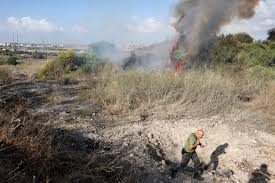
On Sunday, Yemen’s Houthi rebels made headlines with a ballistic missile attack near Tel Aviv, a major commercial hub in Israel. The missile, which struck the area despite Israel’s advanced air defense systems, was claimed by Houthi leader Abdul Malik al-Houthi. Although there were no fatalities, the attack intensified regional tensions amidst the ongoing Gaza conflict, which marks its first anniversary since Hamas’ assault on October 7.
Israeli Prime Minister Benjamin Netanyahu responded promptly, warning that the Iran-backed Houthis would face severe consequences for the attack. While the missile caused only minor damage, such as shattered glass at a train station and injuries to civilians rushing to shelters, the symbolic impact was significant. This attack is the latest escalation involving the Houthis, who are increasingly entangled in the broader Gaza conflict as part of Iran’s Axis of Resistance.
Origins of Houthi Missile Capabilities
The Houthis’ ability to conduct long-range missile strikes is rooted in a combination of historical weapons caches, Iranian support, and arms trafficking. Officially known as Ansar Allah, the Houthis emerged from a grassroots religious movement in the 1990s and have grown into a formidable militia with advanced weaponry. The Yemeni civil war, which erupted in 2015, has been pivotal in expanding their missile capabilities.
1. Yemeni Government Missiles: Yemen’s military, during the Cold War, acquired Scud missiles from the Soviet Union and various other ballistic and surface-to-air missiles from sources including North Korea, Iran, Saudi Arabia, and the United States. The Houthis gained access to these missile systems through looting government armories and later through their alliance with former Yemeni President Ali Abdullah Saleh.
2. Iranian Arms and Training: Since the onset of the Yemeni civil war, Iran has been a crucial supporter of the Houthis, providing missile components and training in assembly and launch techniques. Although Iran has not openly acknowledged this support, US and coalition forces have intercepted Iranian missile shipments to Yemen. Iran’s smuggling operations include overland routes through Oman and covert shipments via the Arabian Sea.
3. Spoils of War: The Saudi-led coalition’s military operations have occasionally resulted in the Houthis capturing advanced weaponry, including rocket launchers and anti-tank missiles. Notable incidents include a 2015 mishap involving an air-drop that allowed the Houthis to seize RPG-26 variants. While these captures contribute to their arsenal, they are less significant compared to Iranian support and Yemeni stockpiles.
The Houthis have also advanced their capabilities in unmanned aerial vehicles (UAVs), with drones resembling Iranian models. The Sammad drone series, used in one-way missions, mirrors Iranian designs like the Sayad.
The Houthi-Iran Alliance
The Houthis are part of a larger network of Iranian-backed militias, including Hezbollah in Lebanon and Shiite factions in Iraq. For Iran, the Houthis offer a cost-effective proxy force that destabilizes the Arabian Peninsula and extends Iranian influence into the Red Sea, a crucial global trade route. This alliance underscores Iran’s strategic interest in leveraging regional conflicts to project its power.
Sources By Agencies


